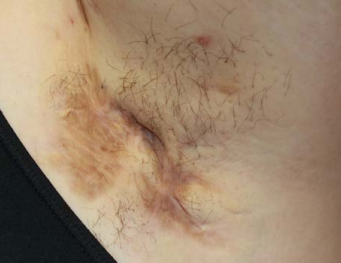How does Hidradenitis Suppurativa affect peoples’ lives?
Pain and foul-smelling suppuration emerging from the lesions associated with HS lead to a significantly reduced quality of life. Patients furthermore experience shame and stigmatization. The disease impacts all aspects of quality of life, including the inability to go to school or work, social isolation, and depression.
Psychological and mental health
Increased anxiety and depression in the HS patient population compared to the general population have been widely reported, although the rates vary widely. A diagnosis of depression has been reported in 42.9% of HS sufferers. Moreover, a cross-sectional study demonstrated a significantly increased risk for completing suicide and suicidality, even after adjusting for confounding variables.
Elevated depression among children and younger people with HS has also been noted. International HS treatment guidelines recommend routine depression and anxiety screening. Bipolar disorder and schizophrenia have also been associated with HS, though such reports are limited.
Substance abuse (specifically cannabis, opioids, and alcohol) has also been reported to be higher among people with HS than controls. These substances have analgesic properties, possibly accounting for their increased use in some people with HS, given the debilitating pain experienced by many with HS.
Influences from the workplace
Disease onset is usually between the second and third decades of life, a critical period for employment choices, opportunities, and career trajectories. Analyses of HS populations from several European countries highlight that HS can profoundly impact professional activity. Unemployment rates in Denmark within the working-age HS population were more than six times higher than that of the general population. Unemployment among HS patients in Ireland was reported to be several times higher than the general population. An analysis of the HS population in Germany showed unemployment rates at twice that of the general population. Furthermore, higher work presenteeism and absenteeism rates in the HS population relative to the general population were also reported.
Work productivity and at-work productivity loss (absenteeism plus presenteeism) have also been shown to be considerably affected by HS in reports from Canada, Denmark, Hungary, and the Netherlands.
International studies report similar trends. Results from the Global Survey of Impact and Healthcare Needs (VOICE) project showed that 14.5% of HS patients were disabled due to their disease. Furthermore, HS symptom severity strongly correlated with a negative impact on work or schooling. The ‘UNITE’ international HS registry reported that only 60% of adults with HS were employed, and some 64% of those employed reported some degree of work impairment due to HS.
Social participation
Social isolation is used by some HS patients as a way of coping with the pain. Daily wound care management concerns many patients and can have a tremendous personal impact. In some cases, self-isolation has been reported as a coping strategy.
People with HS often go to extreme lengths to hide their diseased sites (active signs and scars), avoiding participation in sports. Furthermore, active HS lesions that are painful, discharging, and purulent can make physical activity intolerable, while chronic scarring may limit the range of motion in certain exercises.
Moreover, HS has been shown to profoundly impact sexual activity. Males experience higher sexual dysfunction and a reduced quality of sexual life, while females report higher sexual distress compared with control groups. Notably, sexual desire appears to be largely unaffected in people with HS. The QoL and sexuality of the partners of people with HS have also been shown to be impacted.
Socioeconomic and societal burden
HS can impose a substantial financial burden on the affected individual, healthcare, and society. Many HS patients face considerable out-of-pocket expenses, especially with regard to wound care products. Frustration with ineffective treatment options prompts some to explore complementary and alternative medicines at considerable personal expense.
High levels of healthcare resource utilization in HS patients have been reported. Analysis of claims costs from US databases found that all-cause and HS-specific healthcare resource utilization and costs are high in adults and adolescents with HS. A study from Germany found that the hospital care of HS patients is cost-intensive. A report from Hungary indicates that HS imposes a substantial socioeconomic burden, fueled by work presenteeism and absenteeism, treatments, and informal care. A recent study from Germany highlighted a considerable annual loss of gross value (~ EUR 12 billion) due to unemployment, presenteeism, and absenteeism attributed to HS.

Chronic axillary scarring
Measuring the impact of HS on quality of life (QoL)
HS can cause substantial impairment in QoL in terms of physical, psychological, and social well-being. Disease severity, the impact of surgery, and the unpredictability of HS can exacerbate this impact. A recent pan-European study found that among the most common dermatological diseases, QoL was particularly impaired in people with HS. Among dermatoses, QoL is typically assessed using generic measurement tools such as the Dermatology Life Quality Index (DLQI). The mean DLQI scores for HS (8.3–12.7) are typical for severe dermatoses. In a global study (involving almost 1300 HS patients from five continents), 14.5% reported disability due to the disease, while 81% reported at least one comorbidity (with anxiety and depression at 33% and 36%, respectively), further exacerbating the impact on QoL. In cohabiting HS patients, their cohabitants' QoL can also be impacted, including partners and parents.
The physical symptoms of HS, including pain, pruritus, fatigue, suppuration, and malodour, have traditionally been measured using some of these generic measurement tools. However, HS QoL assessment can be problematic as many generic QoL tools do not capture some HS-specific symptoms. In response, some HS-specific outcome measures have been developed. The Hidradenitis Suppurativa cORe outcomes set International Collaboration (HISTORIC) has developed both patient-reported outcomes and physician-reported measures.

